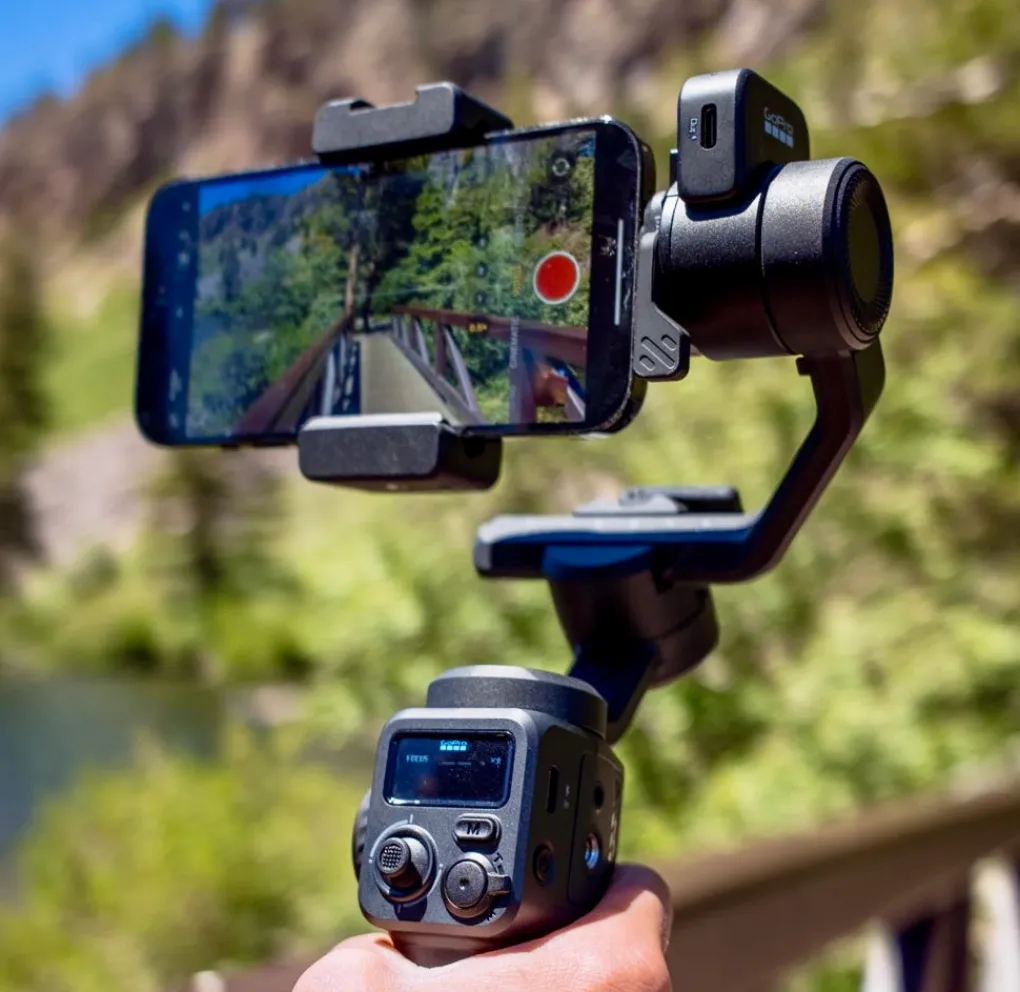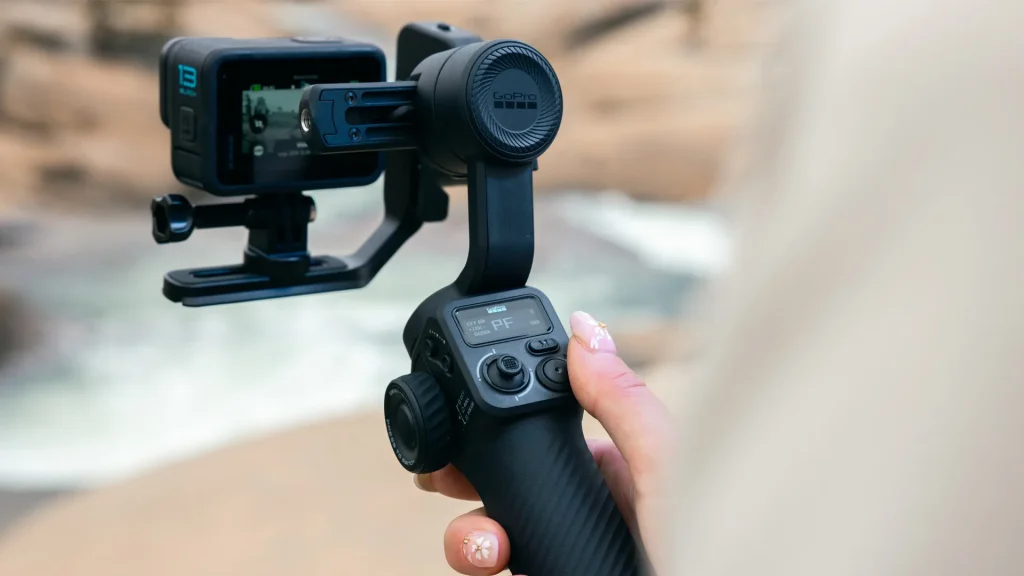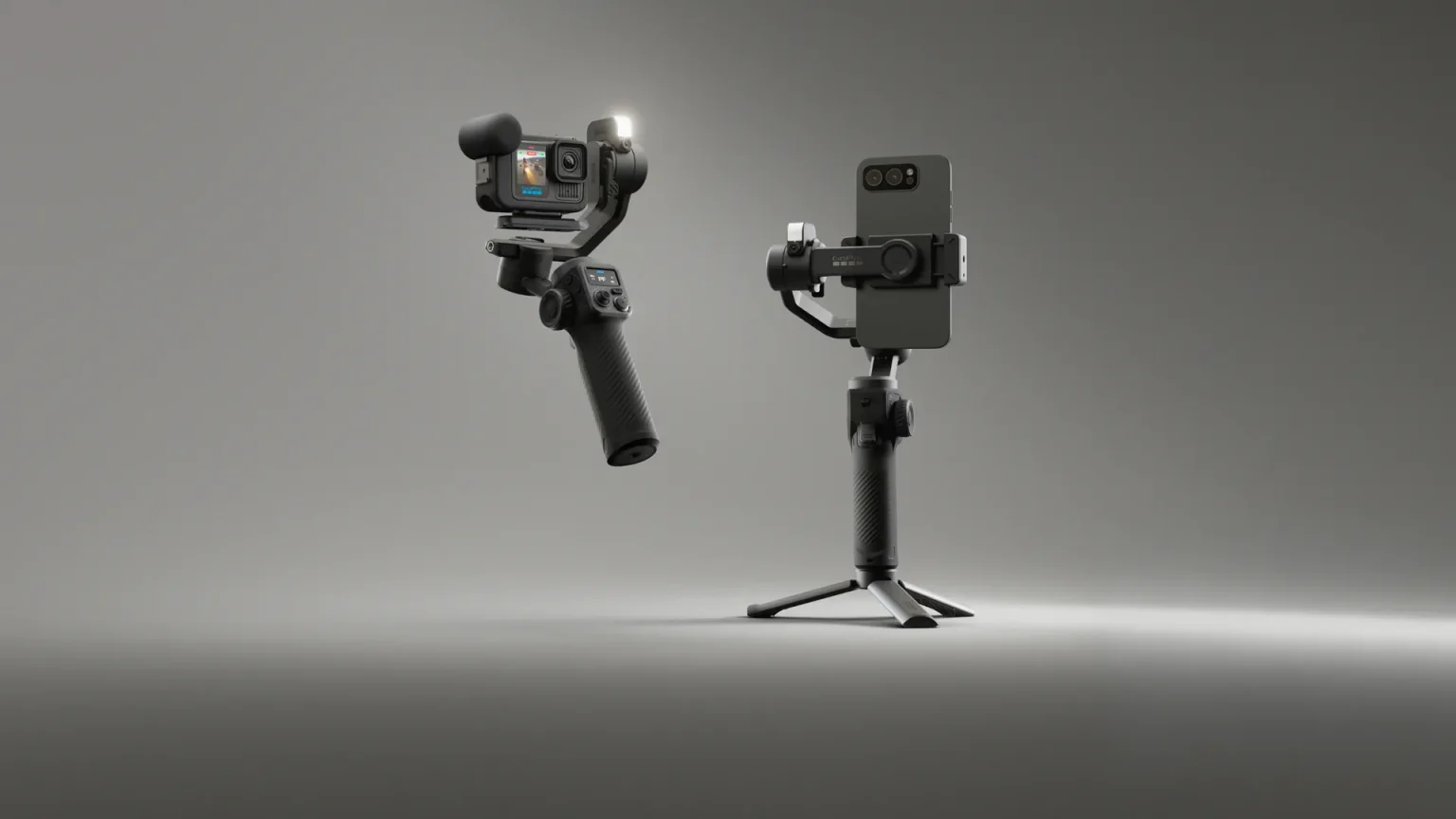It’s been years since GoPro last tried to build its own gimbal. The original Karma Grip was chunky, GoPro-only, and ultimately flopped, dragged down by limited features and the fate of its ill-fated Karma drone. Fast forward to 2025, and GoPro is back with the Fluid Pro AI, a sleek, cross-platform stabiliser with subject tracking, a built-in fill light, and a marathon battery life. It’s GoPro’s first smart gimbal, and it’s trying to take on the likes of DJI and Insta360 at their own game.
I’ve tested it across phones, action cams, trails, pavements, and a few very dodgy lighting situations. Here’s what I found.
Design and Build
The GoPro Fluid Pro AI looks and feels like a serious bit of kit. Weighing just under 1 lb (around 450g), it’s not ultra-light, but it makes up for that with solid construction and weather-resistant seals. Think rugged, not rough. The matte black grip is rubberised and ergonomic, with a practical button layout — joystick, trigger, shutter, and mode select all within easy thumb reach.

It comes with interchangeable mounts for GoPro HERO cameras, smartphones, and even smaller point-and-shoots. The swappable system uses clearly marked arms and tool-less locks, so you can balance and switch devices in under a minute. It also ships with a mini tripod stand that screws into the bottom — great for static tracking shots or hands-free time lapses.
While it lacks built-in selfie stick arms like DJI’s OM series, the trade-off is clear: longer battery life, higher torque, and serious build quality.
Stabilisation Performance
This is where it earns its stripes. Whether paired with a HERO13 Black, a HERO11, or an iPhone 15 Pro, the Fluid Pro AI delivers buttery smooth footage. Walking, panning, climbing stairs — footage came out level and cinematic every time. Older GoPros benefit even more, especially those without the latest HyperSmooth.

More impressive is the gimbal’s 3-axis range of motion. With near 360-degree pan and over 300-degree tilt and roll, it handles dynamic moves like whip pans and follow shots without maxing out or locking. The motors are strong enough to hold larger phones without twitching, even with a small mic or case attached.
AI Subject Tracking
Now for the flashy bit: AI subject tracking. A small sensor on top of the gimbal handles real-time face/body tracking. It works whether you’re filming someone else or flipping the camera for selfie mode. Solo creators, rejoice — you’ve finally got a camera operator that doesn’t get bored.
In practice, the tracking is very good but not quite infallible. It nails most shots with smooth, responsive pans. Face tracking was reliable outdoors and during walking shots. That said, it can drift if you duck out of frame or if the background is too busy. Low light or very fast motion also challenges it. Still, it’s right up there with DJI’s ActiveTrack and Insta360’s Deep Track — which is impressive given it’s GoPro’s first attempt.
Battery Life That Keeps Going
The battery life borders on silly. GoPro claims up to 18 hours from a single charge. I didn’t quite get that far, but even with active tracking and the fill light on, I still got 6+ hours. That’s better than most gimbals get on their best day without any extras switched on.

You can also use the gimbal as a power bank, topping up your GoPro or smartphone via USB-C while you shoot. On long days out, it’s genuinely useful. One fewer thing to charge, one fewer cable in the bag.
Built-in Fill Light and Controls
GoPro added a surprisingly useful LED fill light above the camera mount. It’s not cinema-grade, but for vlogging at dusk or softening harsh shadows, it works well. Perfect for grab-and-go creators.

Controls are intuitive: the joystick lets you reframe, the trigger resets orientation, and the buttons toggle follow modes, record, and lock. Gesture control works too — hold up your palm to start tracking or wave to stop. The companion app (GoPro Fluid) offers panoramas, motion paths, and remote control. It’s clean, stable, and does what it needs to.

Compatibility and Payload
Anything under 400g is fair game. That includes GoPros, most smartphones, and a few compact cameras. No, you can’t mount a mirrorless setup, but that’s not what this gimbal is for. It’s aimed squarely at mobile-first and action-cam creators.
Compared to the Karma Grip — which supported only GoPros and required firmware updates just to behave — the Fluid Pro AI is a massive leap in usability and flexibility.
How It Compares
DJI’s Osmo Mobile 7 and Insta360’s Flow 2 are the closest alternatives. Both are cheaper (around $150), lighter, and a bit smaller. DJI has a more mature app, and Insta360 wins on portability thanks to its clever folding design.
But neither supports GoPros natively. If you film with a GoPro and a smartphone, the Fluid Pro AI is the only stabiliser built for both. It also offers double the battery life — around 18 hours versus DJI/Insta360’s 9–10 hours.
Tracking is competitive too. DJI might still edge it in tricky environments, but GoPro’s fluid tracking is fast, confident, and very usable.
Verdict
After the Karma Grip’s early retirement, expectations were… let’s say measured. But the GoPro Fluid Pro AI is a proper comeback — confident, capable, and actually competitive with the best in the field. With excellent stabilisation, surprisingly strong AI tracking, huge battery life, and cross-device support, it’s an easy recommendation for GoPro fans and hybrid shooters alike.
It isn’t perfect. The higher price, the slightly bulkier frame, and the occasional wobble in complex tracking scenes keep it from taking the crown outright. DJI still has the slicker app, and Insta360 still wins on portability.
But if you want one gimbal that can stabilise your GoPro on a trail and your phone for daily content, this is the most versatile option available right now.
Score: 4/5
Buy it if:
You want a long-lasting, all-in-one stabiliser for both GoPros and smartphones.
Skip it if:
You only shoot on your phone and want the lightest possible setup.
Official Product Page: GoPro Fluid Pro AI
Related Links
DJI Osmo Mobile 7 Pro Review 2025: Tiny Gimbal, Mighty Upgrades
Check out the GoPro Fluid Pro AI gimbal on Amazon
FAQs
Can I use the GoPro Fluid Pro AI with my smartphone?
Yes. It includes a swappable phone mount and supports most modern smartphones up to 400g.
How long does the battery last?
Up to 18 hours in standard use, or around 6 hours with tracking and light active.
Does it support GoPro remote control?
Yes. You can start/stop recording and control modes directly from the gimbal on supported HERO models.
How does its tracking compare to DJI?
Very close. DJI’s ActiveTrack may be slightly better in complex environments, but GoPro’s AI tracking is fast and reliable.
Is it waterproof?
No. It’s weather-resistant (splash and dust proof), but not waterproof.

